Skip to comments.
Arctic's big melt challenged
BBC News Online ^
| Friday, 4 May, 2001
| Jonathan Amos
Posted on 05/19/2002 2:12:28 PM PDT by ancient_geezer
click here to read article
Navigation: use the links below to view more comments.
first 1-20, 21-25 next last
To: *Global Warming Hoax; cogitator
For your attention.
To: ancient_geezer
bttt
To: ancient_geezer
If any journalists were actually interested in digging up some real research data, there are several people working at the Geophysical Institute in Fairbanks and in Finland who have careers in studying sea ice who might have plenty of information.
To: ancient_geezer
US submarines weren't allowed to ...enter Canadian waters LOL. Might be a while for any Canadian subs too. I listen to RCI most nights, before Savage, and the
Canadians bought a few used subs from the UK. Not quiet the low nautical mileage that they thought.
Not that they are accusing the Brits of turning back any odometers, but the refits are taking a lot longer
and costing more than they expected.
To: RightWhale
If any journalists were actually interested in digging up some real research data
They don't even have to work that hard, a quick search on the net provides a stong evidentiary record of what arctic temperatures are actually doing.
Measurements at land sites around the arctic over the last 50 years do not even begin to support the global warming claims that have been tossed around:
What Arctic Station Records Say for graphical representations of Arctic surface temperatures throughout the arctic over the last 50-100 yrs, show no such such trends.
The Bottom Line:
|
Globally Averaged Atmospheric Temperatures
(NASA) 
This chart shows the monthly temperature changes for the lower troposphere - Earth's atmosphere from the surface to 8 km, or 5 miles up. The temperature in this region is more strongly influenced by oceanic activity, particularly the "El Niño" and "La Niña" phenomena, which originate as changes in oceanic and atmospheric circulations in the tropical Pacific Ocean. The overall trend in the tropospheric data is near zero, being +0.04 C/decade through Feb 2002. Click on the chart to get monthly numerical data through April 2002.
|
|
Ice Ages & Astronomical Causes
Brief Introduction to the History of Climate
by Richard A. Muller 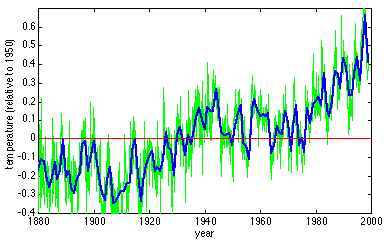
Figure 1-1 Global warming 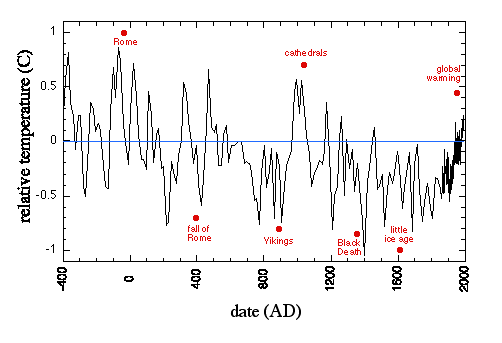
Figure 1-2 Climate of the last 2400 years 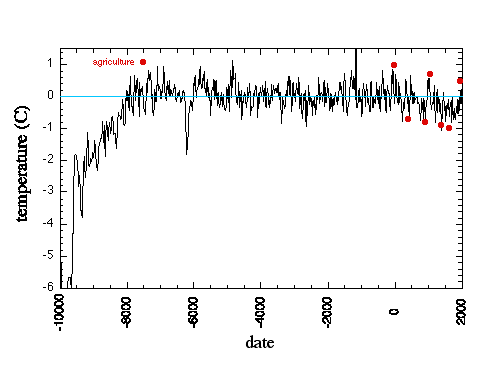 Figure 1-3 Climate of the last 12,000 years 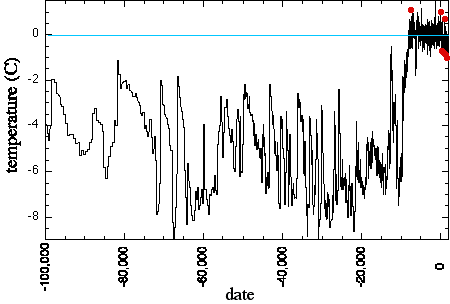
Figure 1-4 Climate of the last 100,000 years 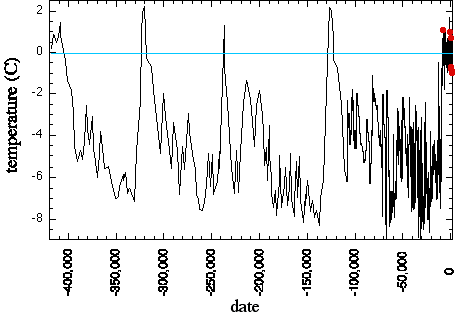
Figure 1-5 Climate for the last 420 kyr, from Vostok ice |
To: RightWhale
Another piece of the puzzle:
http://www.spacedaily.com/news/arctic-01a.html Icelandic Weather System Helps Decipher Arctic Ice Puzzle
Greenbelt - Oct 1, 2001
"Largely natural "ups and downs" in a weather system centered near Iceland have contributed to regional variations and an overall decrease in Arctic sea ice cover over the last twenty years, according to new NASA research."
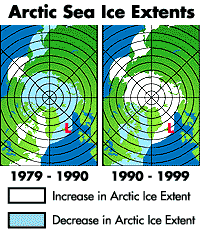
These maps of the Northern Hemisphere show the nine regions that were studied by Claire Parkinson of NASA's Goddard Space Flight Center for trend changes in the sea ice cover before and after 1990, when the North Atlantic Oscillation reached a peak in its annual index. The white color indicates an expansion in the ice cover in a particular region, while the light blue color depicts a reduction in total ice cover. The first map depicts the period from 1979 to 1990 when the North Atlantic Oscillation annual index was generally increasing. This meant an increasing amount of cold air spilling west and south around the semi-permanent Icelandic Low, leading to increased extent of ice (in white) in Baffin Bay/Labrador Sea, Hudson Bay, and the Gulf of St. Lawrence over those regions. Over the same period, to the east of the Low's center, more and more warm air was swept up from the south, reducing ice over the Kara and Barents Seas, the Arctic Ocean, and, to a lesser extent, the Greenland Sea, as designated by the light blue color over those regions. Conversely, in the second map showing the period from 1990 to 1999, ice cover decreased (depicted in light blue) in Baffin Bay/Labrador Sea, Hudson Bay, and the Gulf of St. Lawrence, but increased (in white) in the Kara and Barents Seas, the Arctic Ocean, and the Greenland Sea. "This regional pattern of reversals in the ice extent trends is highly suggestive of an Icelandic Low impact, or, more broadly, of an impact from the North Atlantic Oscillation," Parkinson said. "Still, the satellite data reveal an overall decrease in Arctic sea ice extent since 1978." |
To: ancient_geezer
Thanks for posting all the data. That should help the folks out there to realize that the "global warming problem" does not exist. It is a non-problem.
To: Retiredforever
I have been doing some volunteer work in the lab of a university professor of atmospheric chemistry. He is a really objective person and has no agenda as far as I can determine. He has done some work on the methyl bromide problem. (Methyl bromide is a soil sterilizer--makes agriculture easier, fumigant of imported food and shipping containers entering the U.S., etc. There is a movement to ban its use because it depletes the ozone layer.) The professor's work apparently shows that a very large per cent of the methyl bromide is naturally-occuring. Man's use of it, or discontinued use, may really make no discernable difference. I have a personal hunch that it is part of the warming and cooling cycles that occur naturally.
9
posted on
05/19/2002 5:28:03 PM PDT
by
Pushi
To: ancient_geezer
Great data!
Looking at the 450,000 year climate graph, some things become apparent. The Earth is going to be in another long deep ice age soon. The next ice age will begin in the next 5,000 to 10,000 years. The other thing is that the current temperatures aren't nearly as high as past peeks.
10
posted on
05/19/2002 5:38:14 PM PDT
by
DrDavid
To: ancient_geezer
An ice-free Arctic would likely accelerate any global warming process that was taking place. Can you imagine the increase snowfall in Northern Canada and Greenland that an ice-free Arctic Ocean would cause?
That coupled with the Gulf Stream shutting down from the influx of fresh water from the melting ice would cause the formation of Continental Glaciers within a human lifetime.
To: ancient_geezer
From Fig 1-5 it appears we are about due for a sudden plunge in temperature. In the meantime it looks like we are going to set a record for May 20 in Fairbanks, over 70 degrees!
To: RightWhale; Retiredforever; DrDavid; Mike Darancette
Records of one sort or another get broken somewhere every year. Fairbanks is seeing warm weather, another place is certainly seeing record lows, that is the nature of day to day variation.
As far as a plunge into another glacial period, this inter-glacial has lasted more than 11,000 years from what I understand, the average is around 10Kyrs. Go figure.
Muller gives us some indicators to watch for:
http://muller.lbl.gov/papers/nature.html
Data on noctilucent clouds (mesospheric clouds strongly associated with the effects of high meteors and high altitude dust) supports the hypothesis that accretion increase significantly when the Earth passes through the invariable plane. As shown in Figure 6, a strong peak in the number of observed noctilucent clouds occurs on about July 9 in the northern hemisphere (ref 41, 42) within about a day of the date when the Earth passes through the invariable plane (indicated with an arrow). In the southern hemisphere the peak is approximately on January 9, also consistent with the invariable plane passage, but the data are sparse. The coincidence of the peaks of the clouds with the passage through the invariable plane had not previously been noticed, and it supports the contention that there is a peak in accretion at these times. On about the same date there is a similarly narrow peak is observed in the number of polar mesospheric clouds (ref43) and there is a broad peak in total meteoric flux (ref 44). It is therefore possible that it is the trail of meteors in the upper atmosphere, rather than dust, that is responsible for the climate effects.
Fig 6. Frequency of noctilucent clouds vs. day of year, in (A) the northern hemisphere, and in (B) the sourthern hemisphere (ref 41, 42). The arrows indicate the dates when the earth passes through the invariable plane. The coincidence of these dates with the maxima in the noctilucent clouds suggests the presence of a thin ring around the sun. Peaks on the same dates are seen in Polar mesospheric clouds (ref 44) and in radar counts of meteors.
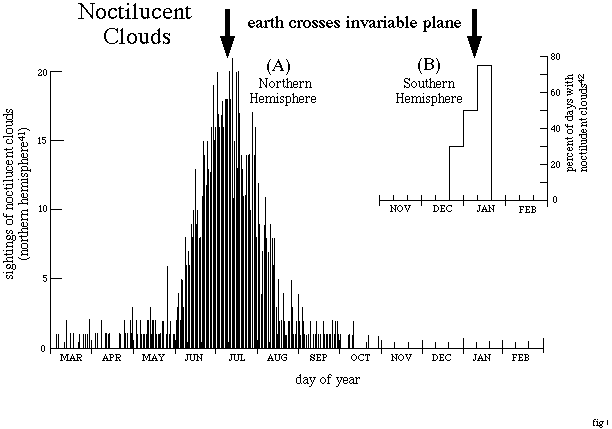
Watch for increased noctilucent cloud cover into April & May, along with higher radar meteor counts. High dust incursions seem to be correlated with sporadic steps into glacial cold periods, which would tend to support Muller's hypothesis. Think periods of sporatic period of cometary material crashing into the earths upper atmosphere, acting simularly to volcanic dust spewed into the stratosphere causing sharp maximum cooling events.

The record above from the Greenland ice sheet shows 2 distinct climate patterns over the last 100,000 years. The first pattern is the general decrease in d18O and the increase in dust content in the middle portion of the record. This middle portion represent the last glacial sitting between two interglacials.
Note The lack of dust and decrease in nonlinear stepwise temperature excursions as the record approaches the current era(low coredepth).
To: ancient_geezer
What is the invariable plane?
To: ancient_geezer
Thanks geezer - I'm Going to bookmark this.
To: RightWhale
"What is the invariable plane?"It's essentially the disc of the solar system—a plane through the Sun's center (more or less), aligned (more or less) to the planets' orbits. Dust, rocks and other crud tend to congregate at this plane. Since Earth's orbit is tilted slightly (less than 2 degrees) with respect to this plane, the Earth passes through the plane twice a year, once going "up" and once "down," and we get more dust and meteors during those periods.
16
posted on
05/19/2002 9:31:21 PM PDT
by
Fabozz
To: RightWhale
What is the invariable plane?
The plane that represents the angular momentum of the solar system, approximately the orbital plane of Jupiter. Earth's orbital plane is offset just a little under 2 degrees from the the invariable plane and precesses about the invariable plane axis in such a was as to bring earths orbit into coincidence with it every 100kyrs.
Most of the solarsystem's cometary mass is found in that plane hence the increase in noctilucent clouds & metoric flux when ever the earth passes through that plane every July.
To: Fabozz
Ahhh heck, yah beat me to it :O)
To: ancient_geezer;Fabozz
Thanks to both of you :)
To: ancient_geezer
;Global Warming Hoax;
Stand Watch Listen;rightwhale;Free the USA;carry_okie...
Good stuff!
Global Warming Hoax :
| To find all articles tagged or indexed using Global Warming Hoax , click below: |
| |
click here >>> |
Global Warming Hoax |
<<< click here |
|
| (To view all FR Bump Lists, click here) |
Navigation: use the links below to view more comments.
first 1-20, 21-25 next last
Disclaimer:
Opinions posted on Free Republic are those of the individual
posters and do not necessarily represent the opinion of Free Republic or its
management. All materials posted herein are protected by copyright law and the
exemption for fair use of copyrighted works.
FreeRepublic.com is powered by software copyright 2000-2008 John Robinson








